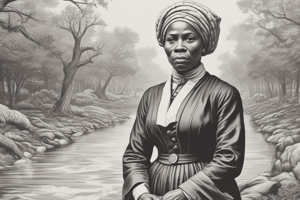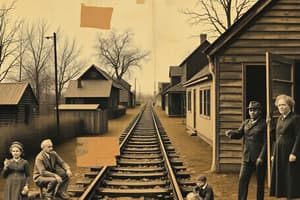Podcast
Questions and Answers
What was the primary purpose of the Underground Railroad?
What was the primary purpose of the Underground Railroad?
- To establish a postal service for confidential communication.
- To transport goods and resources between states.
- To facilitate secret meetings for political discussions.
- To provide a safe passage for enslaved people to freedom. (correct)
The Underground Railroad consisted of what?
The Underground Railroad consisted of what?
- A network of people and secure locations. (correct)
- A series of tunnels connecting different plantations.
- A fleet of ships transporting people along waterways.
- A literal railroad system built underground.
Besides free states, where else did the Underground Railroad help enslaved people escape to?
Besides free states, where else did the Underground Railroad help enslaved people escape to?
- Canada (correct)
- Europe
- Mexico
- South America
Who primarily operated the safe houses along the Underground Railroad?
Who primarily operated the safe houses along the Underground Railroad?
Where did the Underground Railroad guide people away from?
Where did the Underground Railroad guide people away from?
Flashcards
Underground Railroad
Underground Railroad
A secret network aiding enslaved people to escape to free states or Canada.
Secret Network
Secret Network
A hidden system of communication and support for escaping slaves.
Safe Houses
Safe Houses
Places where escaping slaves could rest and hide during their journey.
Free States
Free States
Signup and view all the flashcards
Canada
Canada
Signup and view all the flashcards
Study Notes
The Underground Railroad
- A network of secret routes and safe houses used by enslaved people to escape to free states and Canada.
- It wasn't a literal railroad, but a metaphor for the concealed assistance provided.
- Operated primarily in the mid-19th century, reaching its peak in intensity during the decades preceding the American Civil War.
- Participants included both African Americans and whites, motivated by a variety of factors, including moral opposition to slavery, religious conviction, and humanitarian ideals.
Key Figures and Roles
- "Conductors": Individuals who guided escaping slaves along the way. They might be former slaves themselves or abolitionists from various backgrounds. These conductors took great personal risks.
- "Stations": Refers to safe houses or places of rest where runaway slaves could hide and receive food, shelter, and guidance. These locations could be homes, churches, or other buildings.
- "Passengers": Escaping enslaved individuals. Their journeys often involved great hardship and peril.
- "Agents": Those involved in gathering information, providing financial aid, or organizing escape plans and routes. This involved complex communication networks and close-knit support groups.
Methods and Tactics
- Routes often snaked northwards through a network of hidden trails.
- A code of secrecy was maintained, often relying on oral communications and pre-arranged signals. Information was typically transmitted by word of mouth or in coded messages.
- Slaves often travelled at night, taking advantage of darkness and cover.
- Guides, who knew the land and were familiar with potential dangers, played a crucial role.
Motivations and Goals
- The primary goal for escapees was freedom. Fugitive slaves sought an end to the brutal conditions of slavery and the chance to live in places where they wouldn't be enslaved.
- Abolitionists, who were active proponents of ending slavery, sought to support the slaves’ quest for freedom along the Underground Railroad’s routes and in different locations.
- Religious motivations, stemming from abolitionist viewpoints that viewed slavery as contradicting Christian values, also played a role in individuals' involvement.
- Humanitarian ideals motivated those aiding runaway slaves, highlighting a concern for human rights and well-being.
Challenges and Risks
- Escaping was extremely dangerous. Confederate patrols and slave catchers were constantly patrolling the routes.
- Risks for both the "passengers" and "conductors" included arrest, violence, and re-enslavement.
- Successful escape required bravery, determination, and secrecy. Finding a way through the complicated system of tracking and persecution required a lot of intelligence and quick thinking.
Impact and Legacy
- The Underground Railroad facilitated the escape of hundreds or thousands of enslaved people to freedom.
- Demonstrated the power of collective action and commitment to humanitarian ideals.
- Played a significant role in the growing anti-slavery movement.
- Contributed to the eventual abolition of slavery in the United States.
- The legacy extends beyond the specific routes, showing the importance of networks, courage, and determination in achieving social justice.
Studying That Suits You
Use AI to generate personalized quizzes and flashcards to suit your learning preferences.




